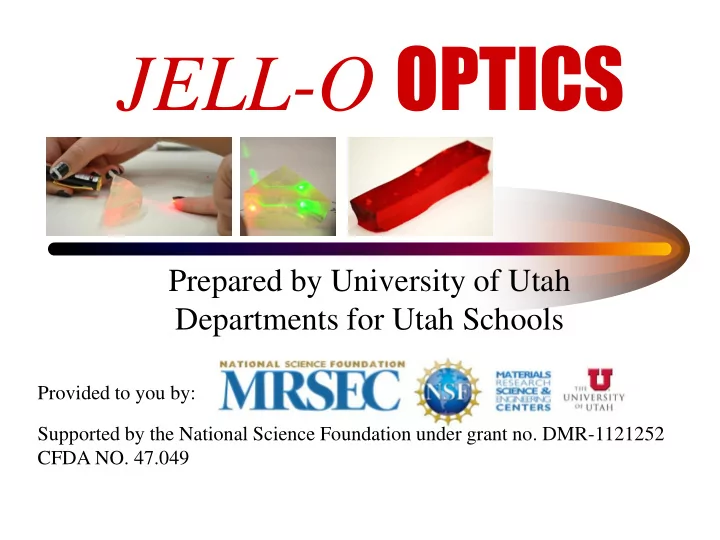

JELL-O OPTICS Prepared by University of Utah Departments for Utah Schools Provided to you by: Supported by the National Science Foundation under grant no. DMR-1121252 CFDA NO. 47.049
Review the Properties of Light • How does light travel? – In a straight line – In waves • What happens when it strikes surface? – It will be • Reflected • Refracted or • Absorbed
How Does Light Bend? • Refraction • Light travels slower through dense materials: • Water • Plastic / Glass & • JELL-O! • Light bends when it enters a substance at an angle. • This is known as REFRACTION!
REFRACTION
What do lenses do? Diverging Lenses (Concave shaped)
What do lenses do? Converging Lenses (Plano-convex lens)
How Does Your Eye Work? • Objects form an upside-down image on the Lens retina. Focal point Retina object image Focal point EYE
How Does Your Eye Work? • We will make a simplification: The image is at the focal point. Lens Retina EYE
How Do We Correct Vision Problems? • Scientists and engineers have found ways to solve these problems. • Corrective lenses. – Glasses – Contacts
What is Near-Sightedness? • The eye is too long and the lens focuses light in front of the retina. Lens Retina EYE
A Diverging Lens Corrects Near-sightedness Diverging Lens Lens Retina EYE
What is Far-Sightedness? • The eye is too short and the lens focuses light behind the retina. Lens Retina EYE
A Converging Lens Corrects Far-sightedness Converging Lens Lens Retina EYE
ENGINEERS CLEAR OUR VIEW • Thanks to Engineering and Science, millions of people have improved vision.
Experiments • Prisms: The purpose of a prism is to bend light. The prism can be used to demonstrate reflection, refraction, and total- internal reflection. Images courtesy of discoveryeducation.com
Experiments • Plano-convex lens: The plano-convex lens can be used to demonstrate the concepts of refraction and focusing.
Experiments • Bi-concave lens: A bi-concave lens works oppositely to a bi-convex or plano-convex lens in that rays that exit the lens diverge rather than converge.
Experiments • The plano-convex lens can be used to demonstrate the concepts of refraction and focusing.
Experiments • The rod can be used to demonstrate the concepts of reflection, refraction, absorption (for colored Jell-O) and total ‐ internal reflection.
Experiments • The glass lens and prism set allows a variety of ways to demonstrate and study the behavior of light. One side is frosted to aid in revealing the path of light.
Experiments • The clear acrylic refraction cells are excellent for showing refraction and internal reflection in water and other liquids and to observe the refractive index.
Videos Jell-O Optics videos are plentiful on YouTube. Here are a few: • U of U Outreach Team (also in Spanish): Part 1: http://www.youtube.com/watch?v=ToLKLDtLo80 Part 2: http://www.youtube.com/watch?v=5Nii9XAv_vg • Science Channel: http://www.youtube.com/watch?v=I4pgO3U5luY (You can skip the ads) • WOWLAb: http://www.youtube.com/watch?v=wavxG4ipj6s
Recommend
More recommend